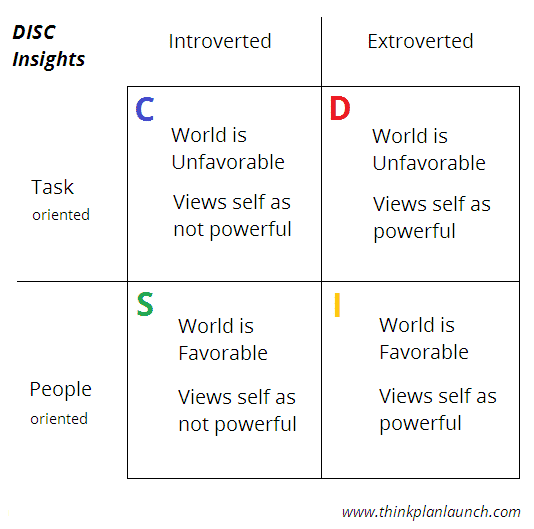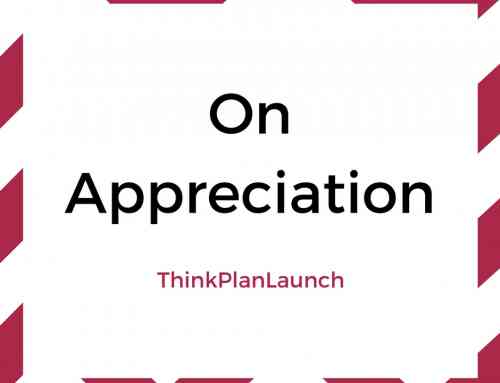In this article, we will explore the nature of the “High-D” as ranked by a DISC test.
Table of Contents
Reminder: DISC measures behavior and communication style.
When we talk about exploring the nature of the High-D, what we are referring to is their visible behavior and communication style.
Remember, DISC is not actually a measure of personality even though many people think of it that way. Behavior and communication style are but two components of personality, which is comprised of many more elements.
“D” stands for Dominant.
The letter “D” in High-D stands for Dominant. Simply put, the High-D is someone who is assertive and domineering. They have incredible energy to get things done, but if you don’t watch out, they might steamroll you in the process! Keep reading to learn more about the High-D.
Summary of the High-D.
- Responsible, determined, and strong-willed.
- Inquisitive, innovative, and pioneering.
- Task-oriented and extroverted.
- Views world as unfavorable.
- Views self as powerful.
- Communicates in a direct manner.
- Gets things done; great leadership potential.
- May steamroll others (unintentionally or intentionally, depending on the person!) in their quest for goal achievement.
- Examples: Mark Cuban, Hillary Clinton, Donald Trump, Barbara Walters.
Adjectives that Describe the High-D.
The High-D is direct in their communication and wants results – now, not yesterday! Here is a list of adjectives associated with the High-D:
- Responsible
- Venturesome
- Decisive
- Competitive
- Aggressive
- Determined
- Ambitious
- Strong-Willed
- Driving
- Risk-Taker
At the extreme (or when under stress), the High-D can become egocentric and demanding! This stems from the High-D’s strong desire for action and results.
As a High-D myself, I can speak to the truth of this. It feels as though there is a constant need for ongoing progress.
Orientation and Attitude of the High-D.
The High-D is task-oriented (as opposed to people-oriented) and extroverted. They view the world around them as unfavorable. However, they believe in their personal ability to effect change upon the world around them. In other words, they view themselves as holding power over their circumstances.
This graph depicts the situation well for all DISC types:

This graph illustrates how each DISC type views the world around them, and how they view themselves; as well as their fundamental orientations.
Since the High-D views the world as unfavorable, someone with a high Dominance score may be prone to feeling they are often in a “hostile” environment.
This, however, is not a black-and-white matter. It does not necessarily mean the High-D is not optimistic, nor does it mean the High-D doesn’t see, feel, or acknowledge the good things in life around them. It also is not a measure of emotional intelligence.
Perhaps the best way to explain how the High-D sees the world is with the world “challenge.” The High-D often seeks out challenges independently, and many times will enjoy those challenges. They may view life itself as a form of challenge, too.
What do you think of when you hear the word “challenge?” Many think of it in terms of overcoming adversity in the pursuit of a goal. The adversity itself may represent a growth or a learning opportunity, and therefore be positive in nature. The High-D may sometimes view adversity as an obstacle in the way of their goals, however.
How the High-D Views Him/Herself.
The High-D typically sees him/herself as positive, confident, and assertive. They may feel they are a “winner.” And the higher the High-D’s emotionally intelligence, the more likely others will perceive them this way, too.
But How do Others View the High-D?
But if the High-D’s emotional intelligence is on the lower end, or if they are under moderate stress, others may come to view the High-D as nervy, aggressive, and demanding!
When the High-D is under extreme stress, their behavior might be perceived as arbitrary, controlling, and overly abrasive. The reason for this is easy to explain.
If a High-D feels like progress is going too slow or they are losing control of a situation, they may take drastic measures to assure goal completion. This might manifest as bossing others around, skipping over any/all courtesies, or angrily huffing and puffing about.
They do these things for the greater goal of progress, and many times it really does come from a place of positive intentions. Unfortunately, the unintended fallout from such behavior can undermine the High-D’s true objectives. It can stir up trouble in relationships, diminish credibility, and reduce buy-in from peers. Therefore the High-D must be careful to keep his/her emotions in check, lest the get the best of him.
The High-D’s Strengths.
Even though the High-D is prone to fly off the handle at times, they have an incredibly long list of strengths. Namely, they are committed to getting things done.
They work hard, initiate activity, and will find ways to make things happen that others cannot, or will not. If they do not know something they must know to accomplish their goal, they will likely learn it – and quickly. They tend to be resilient in the face of doubt, fear, and criticism, and will bounce back from most setbacks stronger than before.
These qualities make many High-D’s excellent leaders, capable of bringing themselves and their teams to new heights. They have a desire to win, a need to direct, and they will communicate in a clear-cut manner.
Because of their high-risk tolerance and general can-do attitude, many High-D’s become successful entrepreneurs, small business owners, or corporate executives.
Since the High-D is a bottom-line organizer, they will cut out needless steps and get the job done in the most efficient way possible – if given the authority. They also tend to seek out change for change’s sake, working towards increasingly more efficient ways of doing things.
In other words, the High-D will challenge the status quo in an effort to find a better way. They are inquisitive and innovative in this regard.
The High-D’s Weaknesses.
Just as the High-D has a long list of strengths, so too they have an incredibly long list of weaknesses. Ouch!
We have already discussed how the High-D can become demanding and abrasive under stress. But what else is there?
Because the High-D is fundamentally impatient, they tend to get frustrated easily. Their impatience may lead them to overstep authority or cross lines that shouldn’t be crossed. The High-D’s intentions may be good when they cross lines (feeling the ends justify the means), but obviously this type of behavior is risky – and it can blow back hard, especially if there are legal ramifications or career-altering implications.
Since the High-D typically seeks the shortest path to results, they may rush through things and be sloppy with details. They may take risks that aren’t well-calculated, or jump into a new project without thinking it through. The same traits that allow them to pioneer new ideas and reach new heights can just as easily bring them down if they’re not careful.
The High-D is also at somewhat of a disadvantage when communicating with others (compared to the other three styles).
Tips for Communicating with a High-D.
“Be brief, be bright, be gone!” is a common jingle to remember, and it will take you far with the High-D – especially if he/she is your boss.
Unlike chatty or analytical types, the High-D typically only wants to talk about what will happen, when it will happen, and who will do it. Many High-D’s are still approachable, however, especially if they are emotionally intelligent.
Things that will upset a High-D include:
- Rambling
- Being disorganized
- Not following up or following through
- Directing or ordering them
- Rhetorical questions
Things that will make a High-D happy include:
- Brief, effective, and to-the-point verbiage
- Logical and efficient presentation of facts
- Providing them with alternatives, options, or choices
- People who are prepared in advance and on-time
- Win-win opportunities
Remember, the High-D is looking for goal achievement and results. They are looking for success, opportunities, and advancement. Along those lines they need a challenge, and thrive on them, and enjoy discussing such matters with trusted friends and colleagues – how they will conquer it.
Speak in terms of the bottom line when communicating with High-D’s and keep a quick pace, and you’ll do alright!
Tips for Communicating with Others as a High-D.
If you are a known High-D (or you’re pretty sure you are!), here’s what you need to know:
As discussed earlier, others can easily come to view you as harsh and abrasive if you’re not careful. What you may view as an effective, results-based attitude could be viewed by others as overly direct and forceful. Some may come to view you as careless, reckless, self-centered in the pursuit of your goals. This can diminish trust, reduce motivation, destroy collaboration, and ultimately foil the plans you care so much about.
As a High-D, it may not feel natural for you to “slow down the pace” and make small talk, but try it out. In your quest for results, you’ll find that forming positive relationships with others is integral to your long-run success. Even if being chatty costs you a few minutes today, being friendly pays big dividends in the long run.
Along those lines, something every High-D should do immediately is check their Emotional Quotient. High scores indicate you’re probably on the right track already in managing your relationships and communication. But even average scores, and especially low scores, can spell trouble – for you, individually – if you let it go unchecked.
By improving your emotional intelligence and people skills, you can channel your High-D energy in a way that motivates others to action and wins them to your cause. Ignore EQ and people skills, however, and you will quickly find yourself without friends or leverage.
The bottom line for the High-D is they should slow down, smile, be friendly, and adjust to the other person’s primary style when communicating. This produces maximum results and leads to the most effective communication.
High-D’s: The Bottom Line.
Throughout this article we have looked at many traits of the High-D: they are goal achievers, direct in their communications, and sometimes a bit blunt. They have a can-do attitude and can move mountains if given the right tools and opportunities; at the same time, they can burn bridges just as easily if they aren’t careful.
How much “High-D” energy do you have?
For any given person, all of traits will be expressed relative to their level of “D” (shown on their DISC graph). The higher the “D,” the more prominent, visible, and obvious are the effects – and the more driving the person becomes. The lower the “D,” the effects are less prominent and the person has a lower sense of urgency.
Dominance relative to the other three behavioral styles.
“D” traits are also expressed relative to a person’s scores in the other three behavioral areas (Influence, Steadiness, and Compliance).
For example, someone with a High-D and a mid-to-high “I” factor may naturally be more friendly and charming than a so-called “Pure-D” who’s running at 95% “D” with little-to-none of the other traits.
Someone with a High-D and a mid-to-high “C” factor may be more adept at calculating risk than a Pure-D.
And the High-D who has a strong “S” will be more stable, patient, and relatable than a Pure-D.
All the same, when a person’s “D” is their strongest factor – and it scores high on their graph (above 50-60%) – you will tend to see them display the traits discussed in this article. Similar to gravity, someone’s primary behavioral style is the strongest “pull” factor for them. It’s the one they will return to naturally, at rest, and/or under stress.
Moving forward.
If you know High-D’s or have them in your life, congratulations – you have just learned a whole lot about them! You now know how to communicate with them more effectively, and you understand them better. You also know how driven and passionate they are, and what they might accomplish if given the right opportunity.
If you are a High-D, you also get a big congratulations! You have learned about yourself, including your strengths and limitations – and what to do about them. Focus on improving your emotional intelligence, and lean on others as necessary to guide you at times (those with other behavioral strengths). This will keep you on track to achieve your many goals in the most efficient way possible.




Leave A Comment